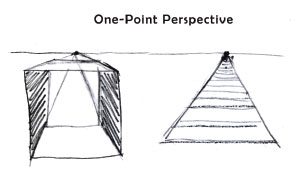There are three types of perspective …
… each one named according to the number of vanishing points it employs.
In one point perspective, such as the classic picture of a head-on railroad track diminishing to a pinprick in the distance, the observer’s line of sight is perfectly in-line with the parallel lines, and so they seem to meet at a single point in the distance.
Objects can be drawn in one point perspective, as can entire city scenes. One point perspective does not translate to “simple.”
In two point perspective, the observer sees two sides of a box (for example). Both sides appear to slant in opposite directions, towards two vanishing points on the horizon line.
Three point perspective occurs when the observer is looking down or up at something very tall, such as a building.
From a worm’s eye view, the building seems to get smaller and smaller as you look up, so those vertical lines are converging upward.
Therefore, there is a vanishing point on the vertical axis as well as the two on the horizon line. Looking down on a building (bird’s eye view), the lines of the building appear to converge downward, so the vanishing point on the vertical axis would be below the building.
Want To Learn More…

Or in simple words, it’s how you make your drawings look real!
You have to study it and know the principles if you have any chance at all of bringing our drawings to life.
Learning perspective is a fundamental element that you need to master before you can draw like a true professional.
The good news is that Perspective Mastery is generously illustrated showing you step-by-step how to make your drawings come to life.
With clear (and fun) instructions on how to draw … you’ll learn at your own pace in the comfort of your home.



